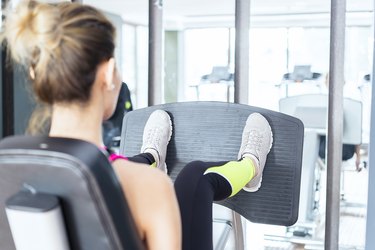
When you want to use a machine to build muscle in your quads and glutes, it's not easy to know which is best. The leg press can be done in a number of different ways; however, they're all fairly similar and work the same muscles.
Therefore, you only need to choose one of the versions — the horizontal or the vertical leg press, plus the 45-degree leg press — to achieve your goal.
Video of the Day
Video of the Day
The main leg press muscles worked are the quadriceps in the thighs and the gluteus maximus in the buttocks. The hamstrings, which are also in the thigh, are secondarily targeted. Adding more leg press weight and varying the angle of the legs changes the emphasis placed upon the muscles.
Horizontal Vs. Vertical
Also referred to as the seated leg press, the horizontal leg press machine requires you to sit in a chair and press your feet against a plate — about 12 to 15 inches apart — which is attached to a weight stack by a long cable. In a neutral position, keep the knees bent and your feet flat on the plate — don't allow to let your heels lift. When you straighten the legs, press against the plate and pull the weights. Don't allow your knees to lock when you extend your legs.
The vertical leg press is similar to the horizontal leg press, except your back should sit against the floor with your legs positioned straight up into the air. The body is bent midsection at a 90-degree angle, and your legs are pressed up against a plate that faces downward. The weight is on top, and straightening the knees presses the weight upward.
45-Degree Leg Press
Not interested in the horizontal leg press machine or vertical leg press? Try the 45-degree angle leg press by sitting in an incline sled and pressing outward with the legs. This is also sometimes known as a vertical leg press, although the legs are positioned halfway between the vertical and horizontal presses.
According to the International Sports Sciences Association the most common mistakes during this leg-press maneuver is to round your back and lift your hips off the pad. Keep your back straight and your hips grounded. As with the other two types of leg presses the 45-degree leg press targets the hips, butt and legs.
Read more: The Average Weight for Leg Press Exercises
Risk of Injury
The risk of injury compared to other leg exercises is significantly reduced in the 45-degree and vertical leg press, where the burden is assumed by the legs and the back is in a stabilizing position.
In the vertical leg press, the body movement isn't actually working directly against gravity, despite the upward mobility of the weights, so there isn't an additional strenuous pressure upon the legs. However, the horizontal leg press is not necessarily a risky move if done with proper form. ExRx.net recommends adjusting the back and seat of the machine to allow yourself a full range of motion so your waist doesn't bend.